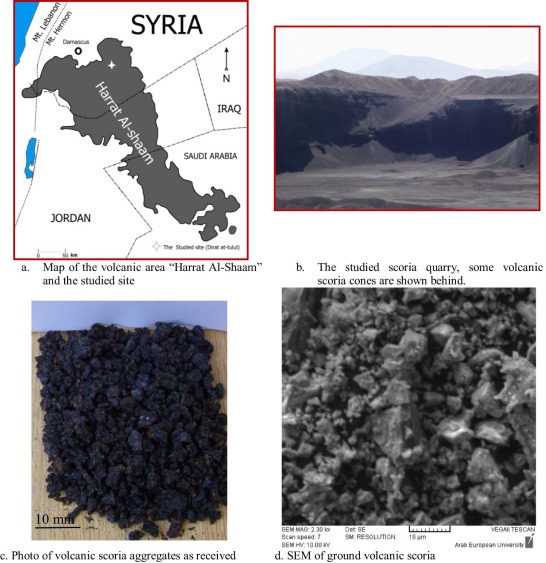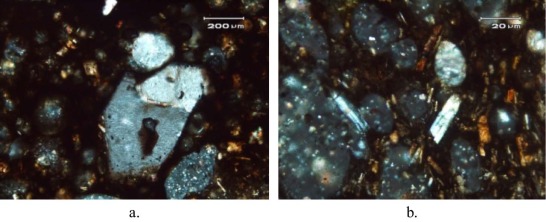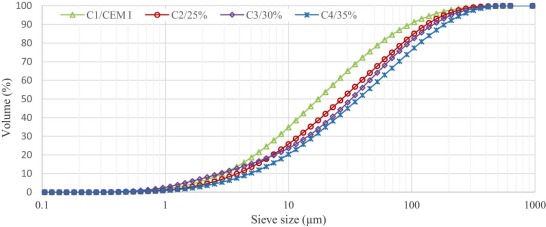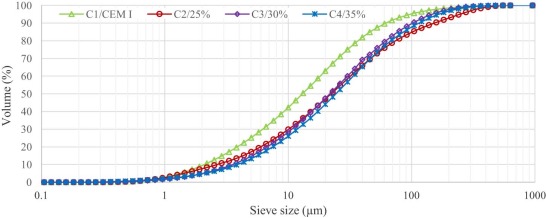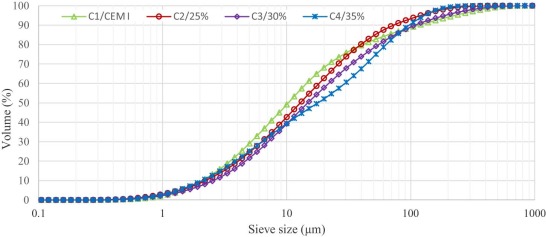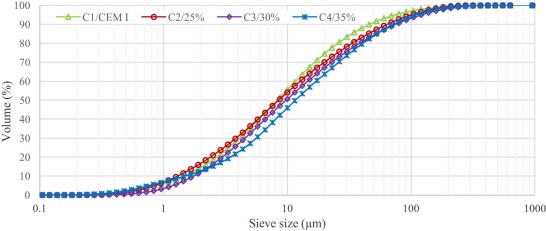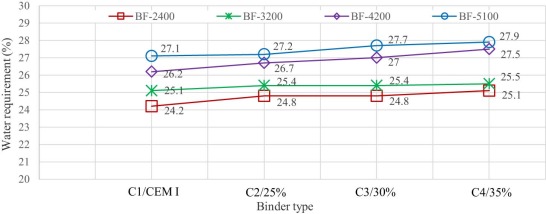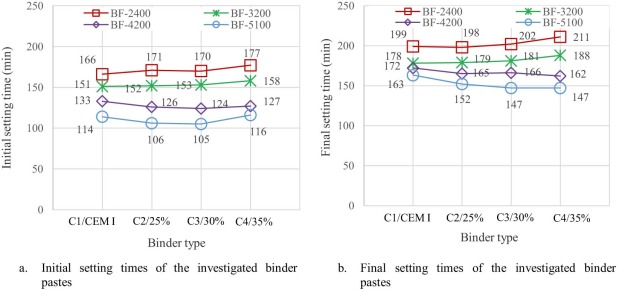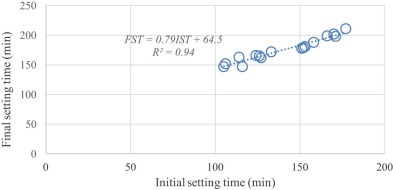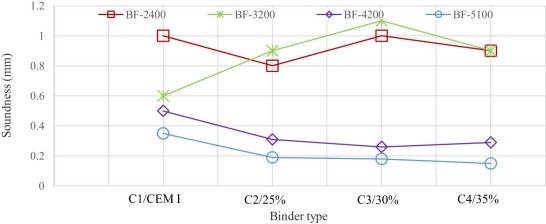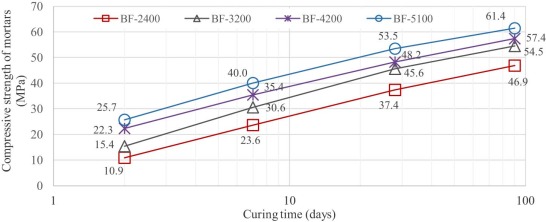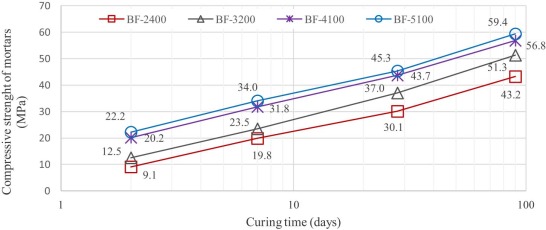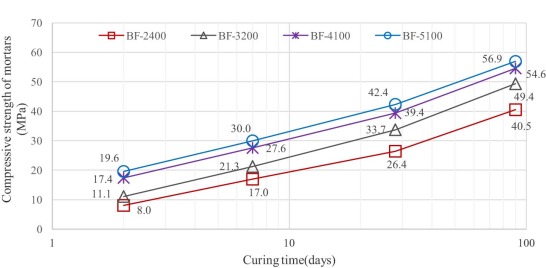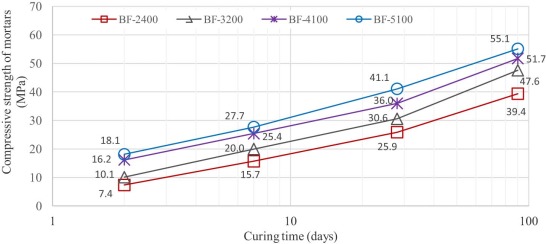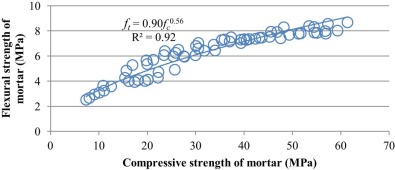Abstract
The benefits of using natural pozzolan as cement replacement are often associated with shortcomings such as the need to moist-curing for longer time and a reduction of strength at early ages. The objective of the study is to investigate the influence of binder fineness on the mechanical strength development of scoria-based binder mortars. In the study, mortar specimens have been produced with four types of binder: one plain Portland cement (control) and three scoria-based binders with three replacement levels: 25%, 30% and 35%, respectively. All scoria-based binders have been inter-ground into four different Blaine fineness: 2400, 3200, 4200 and 5100 cm2 /g. The development of the compressive and flexural tensile strength of all mortar specimens with curing time has been investigated. The effects of the Blaine fineness of the scoria-based blended cement on the compressive and flexural strengths of mortar have been evaluated at curing ages of 2, 7, 28 and 90 days, respectively. Particle size distribution measured by a laser diffractometer has been considered in the study. Test results revealed that there is a decrease in strength with increasing amounts of scoria. In addition, there was found an increase in strength with increasing the Blaine fineness values. No direct relationship between Blaine and particle size distribution was observed. Effects of Blaine fineness on some physical properties of blended cements such as water demand, setting times and soundness have also been investigated. Further, an estimation equation for strength development incorporating the effects of fineness measured either by Blaine or by particle size distribution has been derived by the authors.
Keywords
Mechanical properties ; Fineness ; Blended cement ; Natural pozzolan ; Volcanic scoria
1. Introduction
The term pozzolan, originally applied to a kind of volcanic tuff found at Pozzuoli, is now used generically to define materials which, while not cementitious per se, have constituents that at ambient temperature combine with lime in the presence of water to form compounds that behave like hydraulic binders [1] . Pozzolans have been in use since antiquity. Roy and Langton (1989) [2] suggested that calcined clays mix with slaked lime were the first hydraulic binder to be made. Malinowsky (1991) [3] reported ancient constructions from 7000BC in the Galilee area using this type of binder. The eruption of Thera in 1500BC , which destroyed part of Santorin Island, was responsible for the appearance of large amounts of ashes used by the Greeks to make mortars that reveal having hydraulic properties. However, the Roman already knew that calcined clay was needed to produce mortars with a high performance [1] . According to [4] , the Roman mortars used for the Hadrians Wall in Britain were made of crushed ceramic material mixed with lime binder.
Nowadays, natural pozzolan is being widely used as cement replacement due to its ecological, economical and performance-related advantageous properties [5] , [6] , [7] , [8] , [9] and [10] . However, its use causes longer setting times and lower early strengths compared with plain Portland cement [11] .
Strength of concrete is commonly considered its most valuable property. It is well-known that an increase in specific surface area of cement causes an increase in mechanical properties of mortars and concretes, especially at early ages. Since hydration starts at the surface of the cement particles, it is the total surface area of cement that represents the material available for early hydration. Thus, the rate of hydration depends on the fineness of cement particles [12] .
To overcome the disadvantages of low early strengths of binders containing natural pozzolans, the prolonged grinding of scoria-based binders could be therefore a solution. Bouzoubaa et al. (1997) [13] reported that increasing the pozzolan fineness increased its strength activity; however, it increased the water requirements. Day and Shi (1994) [14] , by studying the effect of grinding on the strength development of natural pozzolan from Central America, concluded that a good linear relationship existed. They showed that an increase of 1.5 MPa can be expected for every 1000 cm2 /g increase in fineness. Their study included Blaine fineness in the range of 2500 to 5500 cm2 /g. On the contrary, Rossi and Forchielli (1976) [15] in an earlier study did not find any proportionality between the surface area of pozzolans and reactivity with lime for a given material.
Syria has important volcanic areas. More than 30 000 km2 of the country is covered by Tertiary and Quaternary-age volcanic rocks [16] , among which volcanic scoria occupies important volume with estimated reserves of about three-quarter billion tons [17] . However, their potential use in making concrete is not well established.
The cement produced in the country is almost of CEM I, although an addition of natural pozzolan up to 5% was frequently used in most local cement plants. Hence, less than 300 000 tons of these pozzolans are only exploited annually (the annual production of Portland cement in Syria is about 6 million tons) [18] .
This study is part of the first detailed research in Syria to investigate the potential utilization of volcanic scoria as cement replacement in producing Portland-pozzolan cements. In the study, in order to better understand the influence of fineness on the mechanical strength development of volcanic scoria-based binder mortars, compressive and flexural strengths have experimentally been investigated using four Blaine fineness values of 2400, 3200, 4200 and 5100 cm2 /g, respectively. The particle size distribution of the studied binders was also considered in the study. As no significant change in w/b ratio (b: cement + scoria) was observed, its effect on the mechanical strength of mortars could be considered marginal. Some physical properties of the studied scoria-based binder pastes, such as water demand, setting times and soundness have been reported as well.
The study is of particular importance not only for the country but also for other countries of similar geology, e.g. Harrat Al-Shaam, a volcanic field covering a total area of some 45 000 km2 , third of which is located in Syria. The rest covers parts from Jordan and Saudi Arabia.
2. Materials and methods
2.1. Scoria
The volcanic scoria used in the experiments was quarried from Dirat-at-Tulul site, at about 70 km southeast of Damascus as shown in Fig. 1 . The mineralogical analysis showed the volcanic scoria is mainly composed of amorphous glassy ground mass, vesicles, plagioclase and olivine with the following percentages (based on an optical estimate): 20%, 35%, 20% and 25%, respectively. Thin sections of the investigated volcanic scoria are shown in Fig. 2 . The chemical analysis of volcanic scoria used in the study is summarized in Table 1 .
|
|
|
Fig. 1. Map of Harrat Al-Shaam, photos of the studied site, the used volcanic scoria aggregates and SEM of the ground volcanic scoria.
|
|
|
|
Fig. 2. Thin sections of the scoria. a). Microphenocrysts of Olivine in volcanic glass matrix with vesicles, some of which are filled with white minerals. b). Microphenocrysts of elongated plagioclase in volcanic glass matrix with vesicles, some of which are filled with white minerals.
|
| Chemical composition (By mass, %) | Cementitious materials | ||||
|---|---|---|---|---|---|
| Scoriaa | C1/CEM I | C2/25% | C3/30% | C4/35% | |
| SiO2 | 46.52 | 20.69 | 24.00 | 24.33 | 24.61 |
| Al2 O3 | 13.00 | 5.09 | 6.55 | 6.80 | 7.39 |
| Fe2 O3 | 11.40 | 4.23 | 5.43 | 5.47 | 6.31 |
| CaO | 10.10 | 60.62 | 50.30 | 48.00 | 44.84 |
| MgO | 9.11 | 2.46 | 3.87 | 4.11 | 4.63 |
| SO3 | 0.27 | 2.26 | 2.30 | 2.26 | 2.55 |
| Loss on ignition | 2.58 | 1.41 | 1.47 | 1.48 | 1.60 |
| Na2 O | 2.14 | 0.60 | 1.07 | 1.16 | 1.31 |
| K2 O | 0.77 | 0.35 | 0.50 | 0.53 | 0.57 |
| Cl− | <0.1 | 0.023 | 0.018 | 0.019 | 0.019 |
| Insoluble residue | 3.22 | 1.03 | 3.48 | 4.08 | 5.33 |
| Pozzolan activity index [ASTM C 618] | 79 (at 7 days) 85 (at 28 days) | ||||
a. SiO2(reactive) = 42.22% (determined in accordance with EN 196-2; SiO2(reactive) is that fraction of the SiO2 which is soluble after treatment with HCl and with boiling KOH).
2.2. Binder samples
Four binder samples have been prepared; one plain Portland cement CEM I (control) and three CEM II/B-P samples with three replacement levels of 25%, 30% and 35% (EN 197-1). 5% of gypsum was added to all these binder samples. All replacements were made by mass of cement. The replacement levels of volcanic scoria have been adopted as they improved durability-related properties of concrete significantly [5] and [19] . The clinker has been obtained from Adra Cement Plant, Damascus, Syria. All samples have been inter-ground by a laboratory grinding ball mill of 25 kg raw mix capacity into four Blaine fineness values: 2400, 3200, 4200 and 5100 cm2 /g. The inter-grinding process has been adopted as it requires less energy than separate grinding, especially for the production of high fineness products [20] . The Blaine fineness was measured using air permeability method in accordance with the European standard (EN 196-6). The principle is to measure the resistance to air flow through a compact bed of cement powder. The particle size distributions of the binders have been obtained using Malvern Mastersizer 2000; a laser particle size analyzer. Fig. 3 , Fig. 4 , Fig. 5 and Fig. 6 show the particle size distribution of the studied binder for all Blaine fineness values. The chemical and some physical properties of the binder samples produced for this study are shown in Table 1 and Table 2 , respectively. CEM I (the control sample) was designated as C1, whereas scoria-based binders were designated according to the replacement level. For instance, C2/25% and C4/35% refer to the binders containing 25% and 35% of volcanic scoria, respectively.
|
|
|
Fig. 3. Particle size distribution of binders with 2400 cm2 /g Blaine fineness.
|
|
|
|
Fig. 4. Particle size distribution of binders with 3200 cm2 /g Blaine fineness.
|
|
|
|
Fig. 5. Particle size distribution of binders with 4200 cm2 /g Blaine fineness.
|
|
|
|
Fig. 6. Particle size distribution of binders with 5100 cm2 /g Blaine fineness.
|
2.3. Binder mortars
The mortar specimens of all binders used in the experiments have been prepared using these binders and sand meeting the requirements of ASTM C778 . In all mixtures, binder: sand ratio was kept constant as 1:2.75 by weight. Mixture containing CEM I was prepared with a w/b ratio of 0.485, where, b: cement + volcanic scoria. Mixtures containing scoria-based binder have been prepared by changing the w/b ratio in order to obtain a flow within ±5 of that of the CEM I mortar. After being kept in a curing cabinet (RH~95%) for 24 hours, the mortar specimens were de-molded and kept in water at 20 ± 2 °C until the time of testing.
2.4. Physical and mechanical properties
Water requirements, setting times and soundness of all binder paste specimens have been determined in accordance with EN 196-3. Six-halved specimens obtained from the three mortar specimens used in the flexural strength tests have been tested for the determination of compressive strength of mortars under the same laboratory conditions as those applied in the flexural strength test. The compressive and flexural strength development was determined on 40 × 40 × 160 mm prismatic specimens, in accordance with EN 196-1, at ages of 2, 7, 28 and 90 days, respectively. The values reported in the results represent the average of six readings for compressive strength test and the average of three readings for all other tests.
3. Results and discussion
3.1. Properties of scoria and blended cements
As seen from Table 1 , volcanic scoria is considered as suitable material for use as pozzolan. It satisfied the standard requirements for such a material by having a sum of SiO2 , Al2 O3 and Fe2 O3 of more than 70%, a SO3 content of less than 4% and a loss on ignition of less than 10% (ASTM C618 ). SiO2reactive content is more than 25%, as well (EN 197-1). In addition, it has a strength activity index with PC higher than the values specified in ASTM C618 . The chemical properties of volcanic scoria-based binders are also in conformity with the standard requirements (ASTM C595 ). Their contents of MgO and SO3 are less than 6% and 4%, respectively. The loss on ignition is also less than 5% as specified in ASTM C595 .
3.2. Particle size distribution (PSD)
In this study, a laser diffractometer was used to obtain the particle size distribution of the binders used. The particle size distributions are given in Fig. 3 , Fig. 4 , Fig. 5 and Fig. 6 . The particle size distributions as shown in Fig. 3 , Fig. 4 , Fig. 5 and Fig. 6 reveal that C1/CEM I is the finest followed by C2/25%, C3/30% and C4/35%. In addition, volcanic scoria-based binders were coarser than CEM I according to percent values of 45- and 90-µm sieve residue as shown in Table 2 . It is generally agreed that cement particles larger than 45 µm are difficult to hydrate and those larger than 75 µm hardly hydrate completely [21] .
| Blaine fineness (cm2 /g) | Binder type | Residue on 45 µm sieve (%) | Residue on 90 µm sieve (%) | Median particle size (µm) |
|---|---|---|---|---|
| 2400 | C1/CEM I | 15.3 | 7.6 | 17.4 |
| C2/25% | 18.2 | 7.9 | 26.6 | |
| C3/30% | 18.3 | 8.3 | 31.3 | |
| C4/35% | 19.7 | 8.1 | 35.1 | |
| 3200 | C1/CEM I | 13.6 | 6.4 | 13.1 |
| C2/25% | 16.1 | 6.7 | 21.4 | |
| C3/30% | 17.0 | 6.9 | 20.9 | |
| C4/35% | 17.9 | 6.8 | 24.5 | |
| 4200 | C1/CEM I | 9.10 | 5.0 | 10.4 |
| C2/25% | 9.90 | 5.50 | 13.1 | |
| C3/30% | 10.3 | 5.70 | 14.8 | |
| C4/35% | 10.5 | 5.80 | 17.2 | |
| 5100 | C1/CEM I | 7.00 | 2.10 | 8.4 |
| C2/25% | 7.20 | 2.40 | 8.8 | |
| C3/30% | 7.30 | 2.50 | 9.7 | |
| C4/35% | 7.5 | 2.60 | 11.5 |
Further, the particle size of the binders used decreases with an increase in grinding time. Particle size distribution curves showed that volcanic scoria-based binders were generally coarser than CEM I although they have similar Blaine fineness values. The coarse phase in blended cements could be attributed to the clinker component, which was harder to grind compared to the volcanic scoria. However, for 4200 and 5100 cm2 /g Blaine fineness, no coarser phase in scoria-based binders was significantly observed in particle size distribution with respect to CEM 1 (Fig. 5 and Fig. 6 ). This seems to be in a good agreement with previous findings of other investigators [22] . In addition to the most common method characterizing the surface area of a cement; i.e. Blaine air permeability test, D50 has also been employed to characterize the fineness of the studied binders. This parameter is defined as the size for which 50% of the binder consists of larger particles. It is considered one important aspect of the particle size distribution. Table 2 provides the median particle size of the binders used.
3.3. Physical properties of cement pastes
3.3.1. Water requirements
The results of water requirements are given in Fig. 7 . Finer scoria-based binders have a greater water demand. The smaller material particle size absorbs more water (due to the large surface area) [23] . This agrees with the well-known fact of finer particles requiring a greater amount of water to produce a given workability [24] . However, as it can be seen from Fig. 7 , there is no significant change in the water content even for the binder containing 35% of scoria which increased only by less than 5% compared to C1/CEM I, for the same Blaine fineness value. This could be explained by the lubricant effect of volcanic scoria on paste when finely divided [25] and the effect of volcanic scoria shape which was characterized by sharp-edged grains [26] as seen in Fig. 1 (d).
|
|
|
Fig. 7. Water demand of the investigated binder pastes.
|
3.3.2. Setting times
Fig. 8 illustrates the setting times of the control paste and pastes containing scoria-based binders for all Blaine fineness values. The results showed that the setting times increased with volcanic scoria replacement level for Blaine fineness values of 2400 cm2 /g and 3200 cm2 /g. The effect is more pronounced when the scoria content is used at 35% as cement replacement. For example, the highest retardation of the initial and final setting times at this percentage were 177 min and 211 min for 2400 cm2 /g and 158 min and 188 min for 3200 cm2 /g, respectively. This could be due to the pozzolanic reaction between pozzolan and CH liberated during hydration of C3 S and C2 S of clinker, which is usually slower than the hydration of cement [27] . Some researchers related the delay in setting times when using natural pozzolan with the increase of water requirements [28] .
|
|
|
Fig. 8. Initial and final setting times of the investigated binder pastes.
|
On the contrary, volcanic scoria-based binders with 4200 and 5100 cm2 /g Blaine fineness values showed a quite different trend. The setting times decreased with the volcanic scoria replacement level. This behavior could be attributed to a set of reasons as follows: a) the increasing surface area of volcanic scoria content of the paste results in greater inter-particle contact, thus speeds up setting [29] , b) the hydration reaction of pozzolan blended cement is diffusion-controlled [30] . Blaine fineness values of 4200 cm2 /g and 5100 cm2 /g with volcanic scoria content might had accelerated diffusion of water and dissolution of C3 A, and increased the transition of Ca2+ ion into soluble state in water, thus the crystallization rate of CSHs increased and the setting time was shortened [31] . Furthermore, a similar trend has been reported by other researchers for Blaine fineness value of 4200 cm2 /g and relatively high cement replacement levels [32] . The natural pozzolan used in their experiments was of a chemical composition similar to that of the investigated volcanic scoria.
It is also clearly seen from the results obtained that for the same replacement level, the initial setting times were reduced with the gradual increase in Blaine fineness values. For instance, C30 with 2400 cm2 /g Blaine fineness had an initial setting time of 170 min and with 5100 cm2 /g Blaine fineness it had shorter initial setting time which was only 105 min. This seems to be in a well agreement with the literature [22] and [33] . The longer initial setting time at lower Blaine fineness values may be due to the relatively coarser clinker particles in the inter-ground blended cements [34] .
It is worthwhile to note that all the volcanic scoria-based binders are seen to comply with the standard requirements (initial setting time ≥45 min and final setting time ≤420 min) according to ASTM C595 for all Blaine fineness values.
A plot of the initial setting time against the final setting time for the whole tested samples as shown in Fig. 9 indicates that there is a strong correlation between the parameters as the coefficient of determination (R2 ) was calculated to be 0.94. A strong relationship exists between two variables when R2 ≥ 0.85 [35] . Thus, an estimate of the final setting time can be predicted from the Eq. (1) when the initial setting time has been obtained.
|
|
( 1) |
where FST = final setting time (min); IST = initial setting time (min).
|
|
|
Fig. 9. Correlation between initial and final setting times of the investigated pastes.
|
3.3.3. Soundness
CaO and MgO compounds that exist freely in cement may create a swelling effect, and therefore their presence should be limited. Since the free lime ratio will decrease as the natural pozzolan addition ratio increase, a decrease in the soundness can be expected. Results of the experiments conducted to see these effects are shown in Fig. 10 .
|
|
|
Fig. 10. Volume expansion of the investigated binder pastes.
|
According to the experimental results, soundness decreases as the volcanic scoria content increase. The volume expansions of samples having higher amounts of volcanic scoria show a noticeable drop compared to the control, particularly with 4200 cm2 /g and 5100 cm2 /g Blaine fineness, which shows that finer scoria-based cement can make an important contribution to concrete durability. Interpretation of these results is currently beyond our understanding and needs further investigation, although all soundness results were much less than 10 mm as specified in EN 197-1.
3.4. Mechanical strengths of mortars
3.4.1. Compressive strength
First of all, it is worthwhile to mention here that no significant change in w/b ratio was found. This was evidenced by the results of water demand of the investigated pastes. So, its effect on mechanical strength of mortars could be considered marginal.
The results of compressive strength development for all mortar mixes containing varying amounts of volcanic scoria are given in Fig. 11 , Fig. 12 , Fig. 13 and Fig. 14 . As expected; all mortars show an increase in strength with curing time. Mortar specimens containing CEM I have higher compressive strengths at any curing time compared to volcanic scoria-based binder mortars. Also, it is seen that the compressive strength of volcanic scoria-based binder mortars decreases with the scoria replacement level for all curing times. For instance, the compressive strength of CEM I and C4/35% cement mortars with 3200 cm2 /g Blaine fineness at 7 days decreased from 30.6 to 20.0 MPa, respectively. This could be explained by (i) the reduction of cement content in the mix with the increase of volcanic scoria content; i.e. the dilution effect [36] and (ii) the slowness of the pozzolanic reaction between the glassy phase in volcanic scoria and the CH released during cement hydration. However, due to the continuation of this reaction and the formation of a secondary C-S-H, a greater degree of hydration is achieved resulting in strengths after 90 days curing which are comparable to those of CEM I specimens [5] . For instance, the compressive strength of C2/25% with 3200 cm2 /g Blaine fineness was found to be 19% lower than CEM I at 2 days curing, but this reduction was only 6% after 90 days curing. It is also clearly seen in Fig. 11 , Fig. 12 , Fig. 13 and Fig. 14 that all volcanic scoria-based binder mortars exhibited steeper slops with curing time. The significant gain in strength in blended cement mortars occurred when moving from 28 to 90 days curing times while in CEM I specimens this was noted during the first 28 days. This could be explained by the slow pozzolanic reaction and its progress with age in volcanic scoria-based binder mortars.
|
|
|
Fig. 11. Correlation between compressive strength of CEM I mortar and Blaine fineness of cement at different curing times.
|
|
|
|
Fig. 12. Correlation between compressive strength of C2/25% mortar and Blaine fineness of cement at different curing times.
|
|
|
|
Fig. 13. Correlation between compressive strength of C3/30% mortar and Blaine fineness of cement at different curing times.
|
|
|
|
Fig. 14. Correlation between compressive strength of C4/35% mortar and Blaine fineness of cement at different curing times.
|
The fineness of cement is a major factor influencing its rate of hydration, since the hydration reaction occurs at the interface with water [37] . Greater cement fineness increases the rate at which cement hydrates and thus accelerates strength development. The influence of greater fineness on mortar strength is manifested principally at the early ages. Based on the results plotted in Fig. 11 , Fig. 12 , Fig. 13 and Fig. 14 , prolonged grinding of the volcanic scoria-based binders from 2400 to 5100 cm2 /g Blaine fineness increased the compressive strength by144%, 143% and 146% at 2 days curing and by 72%, 77% and 76% at 7 days curing but only by 37%, 40% and 40% at 90 days curing for C2/25%, C3/30% and C4/35%, respectively. This could be explained by the effect of grinding which breaks the vitreous body and increases their surface area, resulting in higher activity [38] . In addition, according to Shi (2001) [11] prolonged grinding decreases the particle size and increases dissolution rate and solubility of natural pozzolan, which will accelerate pozzolanic reaction rate and strength development of mortar containing natural pozzolan. Further, when clinker and natural pozzolans are interground, the finer portion of the blended cement is mostly ground natural pozzolan, whereas the coarse portion is mostly ground clinker [20] . This could be confirmed by the high porosity of the studied volcanic scoria which may be an advantage for easy and economical crushing [39] .
Further, it is evidently seen that moving from 3200 cm2 /g (which is a customary value in cement production) to 4200 cm2 /g Blaine fineness had a very obvious influence on the results, whereas this influence was less marked when the Blaine fineness increased from 4200 to 5100 cm2 /g. It can also be concluded that an increase of about 5 MPa can be expected for every 1000 cm2 /g increase in Blaine fineness for volcanic scoria-based binder mortars at all curing times.
3.4.2. Flexural tensile strength
Results of flexural tensile strength of the prisms prepared from the produced binder mortars and cured in water until the test dates are arranged in Table 3 . The values given in the table show the average of flexural tensile strength for 3 samples. A similar trend to that observed for compressive strength seems to be followed by the flexural strength results. However, the results show that flexural strength is less sensitive than the compressive strength to the binder Blaine fineness. For instance, as given in Table 3 prolonged grinding of the volcanic scoria-based binders from 2400 to 5100 cm2 /g Blaine fineness increased the flexural strength by 45%, 50% and 62% at 2 days curing and by 14%, 15% and 23% at 7 days curing but only by 8%, 7% and 12% at 90 days curing for C2/25%, C3/30% and C4/35%, respectively.
| Binder type | Blaine fineness (cm2 /g) | Flexural strength (MPa) – normalized | |||
|---|---|---|---|---|---|
| 2 days curing | 7 days curing | 28 days curing | 90 days curing | ||
| C1/CEM I | 2400 | 3.65–100% | 6.4–100% | 7.5–100% | 7.92–100% |
| 3200 | 4.27–117% | 7.05–110% | 7.94–106% | 8.32–105% | |
| 4200 | 4.73–130% | 7.28–114% | 8.3–111% | 8.57–108% | |
| 5100 | 4.92–135% | 7.35–115% | 8.4–112% | 8.69–110% | |
| C2/25% | 2400 | 2.95–100% | 5.66–100% | 6.81–100% | 7.46–100% |
| 3200 | 3.59–122% | 6.08–107% | 7.16–105% | 7.78–104% | |
| 4200 | 4.13–140% | 6.43–114% | 7.47–110% | 7.99–107% | |
| 5100 | 4.28–145% | 6.45–114% | 7.53–111% | 8.03–108% | |
| C3/30% | 2400 | 2.67–100% | 5.29–100% | 6.51–100% | 7.29–100% |
| 3200 | 3.25–122% | 5.71–108% | 6.91–106% | 7.69–105% | |
| 4200 | 3.94–148% | 5.99–113% | 7.31–112% | 7.87–108% | |
| 5100 | 4.02–150% | 6.07–115% | 7.38–113% | 7.79–107% | |
| C4/35% | 2400 | 2.53–100% | 4.85–100% | 6.26–100% | 7.04–100% |
| 3200 | 3.09–122% | 5.37–111% | 6.61–106% | 7.42–105% | |
| 4200 | 4.01–158% | 5.98–123% | 7.33–117% | 7.81–111% | |
| 5100 | 4.09–162% | 5.95–123% | 7.36–118% | 7.85–112% | |
3.4.3. Correlation between compressive and flexural strength
The relationship between the compressive strength (fc ) and flexural strength (ft ) is given in Fig. 15 , and seems to fit well with the relation proposed by ACI 363R (1992).
|
|
( 2) |
|
|
|
Fig. 15. Correlation between flexural and compressive strengths of the investigated mortars.
|
The correlation between the flexural strength and the compressive strength results were calculated for the entire population of test results, and hence the relation obtained is:
|
|
( 3) |
with a correlation factor of 0.92. So, knowing the compressive strength fc of mortar the flexural strength ft can be predicted by using Eq. (3) .
3.4.4. Correlation between mechanical strengths and fineness
According to the test results, the mechanical strength of mortars containing volcanic scoria-based cements seems to have a close relationship with the binder fineness. For each testing age, linear regression analysis was conducted to determine the best-fit relationship between measured mechanical strengths (compressive and flexural strengths) for all volcanic scoria-based mixtures prepared according to the experimental design and the varying parameters. The independent variables of volcanic scoria percentage and binder fineness measured either by Blaine or by D50 were employed in the following two estimation equations, Eq. (4) and Eq. (5) derived by the authors:
|
|
( 4) |
|
|
( 5) |
where fc , ft are compressive and flexural strength of mortars in (MPa), respectively; NP is the volcanic scoria content; BF is the Blaine fineness of the produced cement (cm2 /g); D50 is the median particle size in (µm) and a, b, c and d are constants. So, the compressive and flexural strengths of CEM II/B-P-based mortars at a given curing time can be predicted from knowledge of the volcanic scoria content and the binder fineness measured either by Blaine or by D50 value.
Table 4 Presents the constants (a, b, c and d) with regression coefficients (R2 ) of the correlation between the experimental data and the proposed equation. However, it should be emphasized that additional factors including the type of natural pozzolan, composition and strength of clinker and w/b ratio may also be effective on the mechanical properties of mortar.
| Curing time (day) | Fineness | Mechanical strength | a | b | c | d | R2 |
|---|---|---|---|---|---|---|---|
| 2 | Blaine (Eq. 4 ) | fc | −4.4144 | 4.8320 | 0.0076 | −0.010 | 0.967 |
| ft | 3.793 | −7.572 | 0.0002 | 0.001 | 0.905 | ||
| D50 (Eq. 5 ) | fc | 43.521 | −58.62 | −1.467 | 2.876 | 0.960 | |
| ft | 4.9476 | −0.056 | −0.0759 | 0.017 | 0.937 | ||
| 7 | Blaine (Eq. 4 ) | fc | 8.904 | −10.808 | 0.0083 | −0.011 | 0.970 |
| ft | 7.8845 | −11.068 | 0.00003 | 0.001 | 0.905 | ||
| D50 (Eq. 5 ) | fc | 61.43 | −80.74 | −1.5903 | 3.092 | 0.978 | |
| ft | 7.494 | −2.668 | −0.0245 | −0.066 | 0.932 | ||
| 28 | Blaine (Eq. 4 ) | fc | 24.892 | −31.990 | 0.0079 | −0.008 | 0.961 |
| ft | 8.7492 | −9.967 | 0.00003 | 0.001 | 0.858 | ||
| D50 (Eq. 5 ) | fc | 75.136 | −84.59 | −1.5703 | 2.818 | 0.983 | |
| ft | 7.6978 | 0.803 | −0.0112 | −0.112 | 0.939 | ||
| 90 | Blaine (Eq. 4 ) | fc | 36.720 | −25.46 | 0.0072 | −0.005 | 0.928 |
| ft | 8.7665 | −6.555 | −0.00007 | 0.001 | 0.837 | ||
| D50 (Eq. 5 ) | fc | 81.231 | −53.43 | −1.4381 | 2.249 | 0.977 | |
| ft | 8.342 | −0.201 | −0.0145 | −0.055 | 0.911 |
From the values shown in Table 4 , it should be noted that the highest R2 values were found in the correlation between mechanical strengths and the fineness measured by D50 value. So, this parameter could be considered more appropriate than Blaine fineness in predicting strengths of volcanic scoria-based mortars. This result was in a good agreement with Osbaeck and Johansen (1989) [40] , who established that the PSD must be utilized when correlating strength development to fineness (as opposed to a single number such as Blaine fineness). It was also reported by Turanli et al. (2004) [41] that the Blaine fineness was not a reliable measure for materials other than Portland cements.
4. Conclusion
Based on the experimental results, the following conclusions could be drawn:
- It can be said that the volcanic scoria deposits located in the studied site is a perfect potential for the cement industry. Volcanic scoria had major chemical components, SiO2 + Al2 O3 + Fe2 O3 , conforming to the chemical requirements of the ASTM and EN standards. In addition, the experimental results presented in this paper showed the physical characteristics of the cement containing scoria are in conformity with the standard requirements.
- No direct relationship between the Blaine fineness and the particle size distribution was observed. The volcanic scoria-based binders were coarser than the reference CEM I, although they have the same Blaine fineness. Thus, due to difference in the grindability of clinker and volcanic scoria, it is suggested that besides the Blaine fineness, particle size distribution may also be determined.
- Contrary to expectation, volcanic scoria-based binders with 4200 and 5100 Cm2 /g Blaine fineness values exhibited shorter setting times with the increase of volcanic scoria replacement level.
- The fineness of volcanic scoria-based binder is an activating property for the mortar mechanical strength, especially during the early ages. Mechanical strengths of mortars were found to substantially increase with volcanic scoria-based binder fineness.
- For all curing times, it was concluded that the worst and best performance in terms of compressive strength was observed in the mortars produced with volcanic scoria-based cement with fineness of 2400 and 5100 cm2 /g, respectively.
- Prolonged grinding of the blended cements to achieve a Blaine fineness beyond 4200 cm2 /g (i. e. 5100 cm2 /g) did not show significant influence on the mechanical strengths of blended cement mortars compared to 4200 cm2 /g. So, for reducing the costs of grinding, it is recommended as a result of this study to reach Blaine fineness of no more than 4200 cm2 /g.
- It was evidently observed that in all mortars containing volcanic scoria, there was a noticeable gain in strength from 28 days onwards, while this was noted during the first 28 days in CEM I specimens.
- All volcanic scoria-based binders with Blaine fineness of 4200 cm2 /g or more are seen to comply with the standard requirements for all strength classes.
- Based on the results obtained, the authors derived an estimation equation for both compressive and flexural strength development incorporating the effects of fineness measured either by Blaine or by D50 . The mechanical strength of mortar containing volcanic scoria-based cement could be adequately predicted either using Eq. (4) or Eq. (5) . Development of such a good relationship between mechanical strengths and the binder fineness can be of considerable benefit. However, it is worthwhile to mention that the D50 parameter was more appropriate for predicting strength than Blaine fineness.
- According to the results obtained, it is suggested that volcanic scoria can be used up to 35% as a partial substitute for Portland cement in production of blended cements when inter-ground to Blaine fineness of 4200 cm2 /g or more if the cost of grinding can be neglected. This addition ratio can provide economical and ecological benefits due to less use of cement and less CO2 emission from production of cement. So, production of greener concrete could be promoted.
Acknowledgments
The authors gratefully acknowledge the technical and financial support of this research from the management of General Organization for Cement and Building Materials/Adra Cement Plant . Thanks are also expressed to Eng. Amjad Bernieh (Lafarge Co.) and Prof. Tamer al-Hajeh, Vice-President of AIU for their appreciated help.
References
- [1] M.I. Sanchez De Rojas Gomez, M. Frias Rojas; Natural pozzolans in eco-efficient concrete; Eco-Efficient Concrete (Ed.), Pacheco-Torgal, Jalali, Labrincha and John, WoodHead Publishing Limited, Cambridge (2013), pp. 83–104
- [2] D.M. Roy, C. Langton; Studies of ancient concretes as analogs of cementitious sealing materials for repository in Tuff; LA-11527-MS, Los Alamos Nacional Laboratory (1989)
- [3] R. Malinowsky; Prehistory of concrete; Concr. Int, 13 (1991), pp. 62–68
- [4] A. Gulec, A. Tulun; Physico-chemical and petrographical studies of old mortars and plasters of Anatolia; Cement and Conc. Res, 27 (1997), pp. 227–234
- [5] A.M. al-Swaidani, S.D. Aliyan; Effect of adding scoria as cement replacement on durability-related properties; Int. J. Concr. Struct. Mater, 9 (2) (2015), pp. 241–254
- [6] N. Kouloumbi, G. Batis, P. Pantazopulou; Efficiency of natural Greek pozzolan in chloride-induced corrosion of steel reinforcement; Cem. Concr. Aggreg, 17 (1) (1995), pp. 18–25
- [7] K.I. Khan, A.M. Alhozaimy; Properties of natural pozzolan and its potential utilization in environmental friendly concrete; Can. J. Civil Eng, 38 (2010), pp. 71–78
- [8] M. Moufti, A. Sabtan, O. El-Mahdy, W. Shehata; Assessment of the industrial utilization of scoria materials in central Harrat Rahat. Saudi Arabia; Eng. Geol, 57 (2000), pp. 155–162
- [9] G.K. Al-Chaar, M. Al-Kadi, P.G. Asteris; Natural pozzolan as a partial substitute for cement in concrete; The Open Construct. Tech. J., 7 (2013), pp. 33–42
- [10] Y. Senhadji, G. Escadeillas, H. Khelafi, M. Mouli, A.S. Benosman; Evaluation of natural pozzolan for use as supplementary cementitious material; Eur. J. Environ. Civ. Eng, 16 (1) (2012), pp. 77–96
- [11] C. Shi; An overview on the activation of the reactivity of natural pozzolans; Can. J. Civil Eng, 28 (2001), pp. 778–786
- [12] A.M. Neville; Properties of Concrete; (fifth ed.)Pearson Education Limited, Harlow (2011)
- [13] N. Bouzoubaa, M. Zhang, A. Bilodeau, V. Malhotra; The effect of grinding on the physical properties of fly ashes and a Portland cement clinker; Cem. Concr. Res, 27 (1997), pp. 1861–1874
- [14] R.L. Day, C. Shi; Influence of the fineness of pozzolan on the strength of lime natural pozzolan cement pastes; Cement and Conc. Res, 24 (8) (1994), pp. 1485–1491
- [15] G. Rossi, L. Forchielli; Porous structure and reactivity with lime of some natural Italian pozzolans; II Cemento, 76 (1976), pp. 215–221
- [16] The General Establishment of Geology and Mineral Resources in Syria (GEGMR); A Guide for mineral resources in Syria; (2011) in Arabic
- [17] The General Establishment of Geology and Mineral Resources in Syria (GEGMR); Official document nr. (3207/T/9) dated 21.11; (2007) in Arabic
- [18] The General Organization for cement & Building Materials (GOCBM); www.cemsyria.com accessed 2011; in Arabic
- [19] A.M. al-Swaidani, R. Ismat, M.E. Diyab, S.D. Aliyan; Prediction of corrosion resistance of concrete containing natural pozzolan from compressive strength; IOP Conf. Series: Mater. Sci. Eng, 96 (2015) 012007
- [20] H. Binici, O. Aksogan, I.H. Cagatay, M. Tokyay, E. Emsen; The effect of particle size distribution on the properties of blended cements incorporating GGBFS and natural pozzolan (NP); Powder Technol, 177 (2007), pp. 140–147
- [21] P.K. Mehta; Concrete, Structure, Properties and Materials; Prentice-Hall, New Jersy (1986)
- [22] B. Uzal, L. Turanli; Studies on blended cements containing a high volume of natural pozzolans; Cement and Conc. Res, 33 (2003), pp. 1777–1781
- [23] R.P. Jaya, B.H. Abu Bakar, M.Z.M. Johari, M.H.W. Ibrahim; Strength and permeability properties of concrete containing rice husk ash with different grinding time; Cent. Eur. J. Eng, 1 (1) (2011), pp. 103–112
- [24] R. Walker, S. Pavia; Physical properties and reactivity of pozzolans and their influence on the properties of lime-pozzolan pastes; Mater. Struct, 44 (2011), pp. 1139–1150
- [25] S. Yetgin, A. Cavdar; Study of effects of natural pozzolan on properties of cement mortars; J. Mater. Civil Eng, 18 (6) (2006), pp. 813–816
- [26] A.R. Pourkhorshidi, M. Najimi, T. Parhizkar, F. Jafarpour, B. Hillemeier; Applicability of the standard specifications of ASTM C618 for evaluation of natural pozzolans; Cem. Concr. Comp, 32 (2010), pp. 794–800
- [27] D.A. Adesanya, A.A. Raheem; Development of corn cob ash blended cement; Construct. Build. Mater, 23 (1) (2009), pp. 347–352
- [28] A. Colak; Characteristics of pastes from a Portland cement containing different amounts of natural pozzolan; Cement and Conc. Res, 33 (2003), pp. 585–593
- [29] S. Targan, A. Olgun, Y. Erdogan, V. Sevinc; Influence of natural pozzolan, colemanite ore waste, bottom ash, and fly ash on the properties of Portland cement; Cement and Conc. Res, 33 (2003), pp. 1175–1182
- [30] C. Plowman, J.G. Cabrera; Mechanism and kinetics of hydration of C3A and C4AF extracted from cement; Cement and Conc. Res, 14 (1984), p. 238
- [31] P. Sidheswaran, A.N. Bhat; Impact of zeolitic water content on exchange of calcium ions; Thermochim. Acta, 298 (1997), p. 55
- [32] M. Ghrici, S. Kenai, E. Meziane; Mechanical and durability properties of cement mortar with Algerian natural pozzolana; J. Mater. Sci, 41 (2006), pp. 6965–6972
- [33] A.W. Hago, A.A. Al-Rawas, A. Al-Sidairi; Effect of the fineness of artificial pozzolan (sarooj) on properties of lime-pozzolana mixes; J. Sultan Qaboos Univ. (2002)
- [34] S. Tsivilis, S. Tsimas, A. Moutsatsou; Contribution to the problems arising from the grinding of multicomponent cements; Cem. Concr. Res, 22 (1) (1992), pp. 95–102
- [35] D.C. Montgomery, E.A. Peck; Introduction to Linear Regression Analysis; Wiley, New York (1982)
- [36] K.M.A. Hossain; Blended cement using volcanic ash and pumice; Cement and Conc. Res, 33 (2003), pp. 1601–1605
- [37] F.M. Lea; P.C. Hewlett (Ed.), Leas Chemistry of Cement and Concrete (fourth ed.), Butterworth-Heinemann, Elsevier Ltd., Oxford, UK (1998)
- [38] W. Chen; Hydration of slag cement; Ph.D. thesis; University of Twente, Netherland (2007)
- [39] G. Kelling, S. Kapur, N. Sakarya, E. Akca, C. Karaman, B. Sakarya; Basaltic Tephra: potential new resource for ceramic industry; Br. Ceram. Trans, 99 (2000), pp. 129–136
- [40] B. Osbaeck, V. Johansen; Particle distribution and rate of strength development of Portland cement; J. Am. Ceram. Soc, 72 (2) (1989), pp. 197–201
- [41] L. Turanli, B. Uzal, F. Bektas; Effects of mineral characteristics on the properties of blended cements containing high volumes of natural pozzolans; Cement and Conc. Res, 34 (2004), pp. 2277–2282
Document information
Published on 10/04/17
Licence: Other
Share this document
Keywords
claim authorship
Are you one of the authors of this document?

